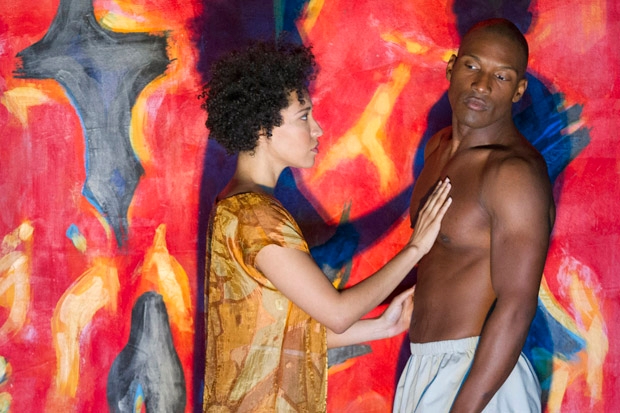When is an opera not an opera? How much can you strip and peel away, or extend and graft on to the genre, before it simply ceases to be itself? These questions dominated a week in which directors turned vivisectors for new productions — reimaginings — of Purcell’s Indian Queen (ENO) and Mozart’s Don Giovanni (Silent Opera).
Anyone familiar with Peter Sellars’s work will know better than to expect any paring back from the larger-than-life American. Amplification is the order of the day for Purcell’s semi-opera — expanded from a trim 50 minutes of unfinished music yoked to a play by Dryden and Howard to a three-and-a-half-hour musico-dramatic spectacle. If that sounds pretentious and portentous, then that’s about right.
Dryden is out, replaced by the living Nicaraguan author Rosario Aguilar. Extracts from The Lost Chronicles of Terra Firma (mesmerisingly spoken by the actress Maritxell Carrero) rewrite the original dynastic feud between Peru and Mexico as a colonial conflict between the Mayans and the Spanish conquistadors. A battle of equals becomes a rout, a portrait of colonial brutality and exploitation with the inter-race marriage of Don Pedro (Noah Stewart) and Teculihuatzin (a radiant Julia Bullock) as its emotional prism.
Colonialism is bad. As a message it’s unarguable, but also of limited dramatic interest. A tale of cruelty and horror (the half-time climax is a massacre) demands a pretty unvarying musical palette. Sellars summons all of Purcell’s minor-key music — arias, airs, sacred anthems — to his aid, creating a pasticcio score that extends from sorrowful (‘O solitude’) to tragic (‘Hear My Prayer’), with only the occasional foray into wistful. Where are the swift, joyful dance rhythms that are the heartbeat of baroque music?
Visually we’re in classic Sellars territory. Colourful canvases by the Chicano artist Gronk make big, primitive gestures, mirrored in Christopher Williams’s choreography (Rite of Spring by way of Rambert). The chorus struggle to find their place in this exotic, uninhibited world, not helped by costumes that make them look like refugees from the local WI’s production of Hair. They are equally at sea in Purcell’s anthems. This is choral music sung in chorus style, which never finds the balance, the blend, the accuracy that such musical exposure demands. The soloists are better, though still strikingly unidiomatic at times, leaving Lucy Crowe (Doña Isabel) as a sole beacon of period style and beauty.
The Indian Queen feels like a first-draft show. With some severe editing things could be different, but lay umpteen miniature masterpieces end to end and each undercuts the next until musical impact is negligible. Reactions to the production’s opening run in Madrid in 2013 said as much, but little has changed in this second iteration. This is still a musical tale lost in the telling.
If Sellars is just a girl who can’t say no, it’s not a problem shared by Silent Opera. This bold young company has taken its signature technology-driven productions to newly minimal extremes with Giovanni — a contemporary reworking of Mozart’s classic that jettisons orchestra and most of the cast for an hour-long show with only two live singers.
In case the underground tunnel setting (Waterloo trains rattling overhead) isn’t clue enough, this is opera brutally severed from the umbilical cord of the opera house. With that you might shed preconceptions and pretensions, but unfortunately you also lose technical scaffolding. Giovanni has been sold as the first opera with its own integrated app; audiences can interact with the characters and even decide the Don’s fate — life or death. Owing to the vagaries of underground Wi-Fi it doesn’t and you can’t. Which is a shame, because what’s left doesn’t add up to an opera.
Let’s start with the good: the cast are exceptional. Mary Bevan and Keel Watson (Donna Elvira, Commendatore) are classy digital shadows, heard only in recordings wittily integrated into the show, while Frederick Long makes a personable Leporello. If this was Benedict Nelson’s audition for a shot at a full-scale Don, then it’s a successful one. He’s the guiding emotional thread through this maze of a Giovanni, dispatching what’s left of his music with bags of character. A startling, simple ‘Deh vieni’ is the highlight of the evening. Unfortunately, this moment of undiluted Mozart exposes the noisy emptiness all around it.
A digital ‘score’ mashing up Mozart with spoken word, club beats and digital textures lacks expressive range. Yes, it’s clever and contemporary, but does anyone want to listen to a mobile ringtone for an hour? This lack of textural differentiation denies the opera any real climax. Director Daisy Evans makes no attempt to rewrite the Commendatore ghost story, so we’re left with a rather apologetic conclusion to a contemporary fable that seems tacked on from another tale, set to music not noticeably different to that of the past hour. Nelson sits, head in hands, as well he might.
Silent Opera has some big, exciting ideas, but every production to date has struggled to match vision with technological execution. At what stage do we stop writing subjunctive reviews, hoping for better, and start admitting that it’s just not working.






Comments